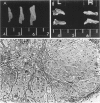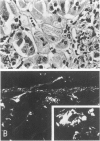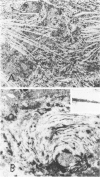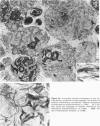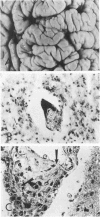Abstract
We describe the detailed clinical, pathologic, and biochemical features of brother and sister with the neonatal onset form of adrenoleukodystrophy, together with evidence of the biochemical defect. When compared with reports of previous cases, it becomes clear that this is a newly described clinical entity with remarkable uniformity of signs and very different from the usual childhood form. Some pathologic features are shared, including the morphologic abnormality of the adrenal in both neonatal and childhood forms, but deposition of abnormally metabolized lipids is more systemic and widespread in the neonatal form. The biochemistry of the disease is presented in both children and parents. Plasma values of long-chain fatty acid C26:0 are 0.328 +/- 0.18 micrograms/ml in a control population and 0.381 +/- 0.312 micrograms/ml in the father and mother. Values for C26:0 in the plasma of childhood adrenoleukodystrophy are 1.62 +/- 0.87 micrograms/ml and in our two cases, 2.79 micrograms/ml in the male, 1.83 micrograms/ml in the female. The basic biochemical defect appears to be a diminished capacity to oxidize these fatty acids leading to accumulation in cholesterol esters. Fatty acid oxidation to CO2 by cultured skin fibroblasts was 51% of control value for stearic acid, 5% for lignoceric acid in the male, and 39% of control value for stearic acid, 5% for lignoceric acid in the female. The genetics of this disease is different; whereas childhood adrenoleukodystrophy is X-linked, the neonatal onset form affects males and females equally and is most probably autosomally recessive in inheritance.
Full text
PDF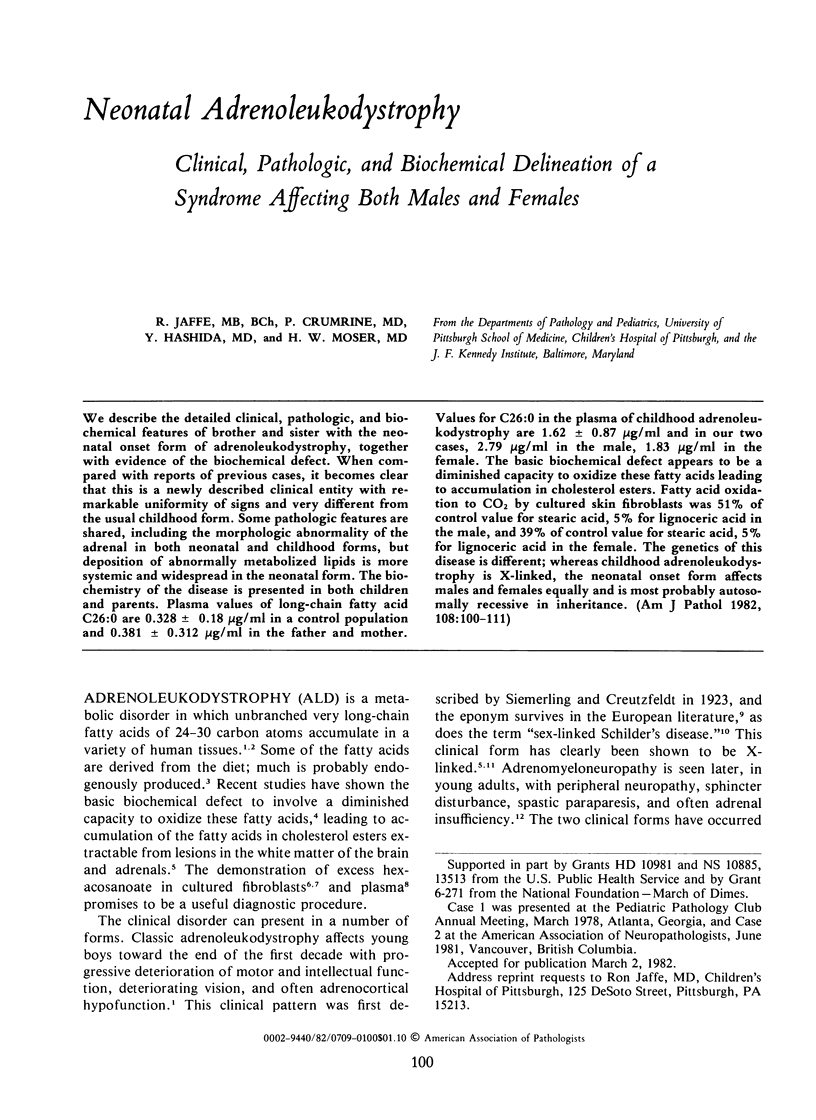
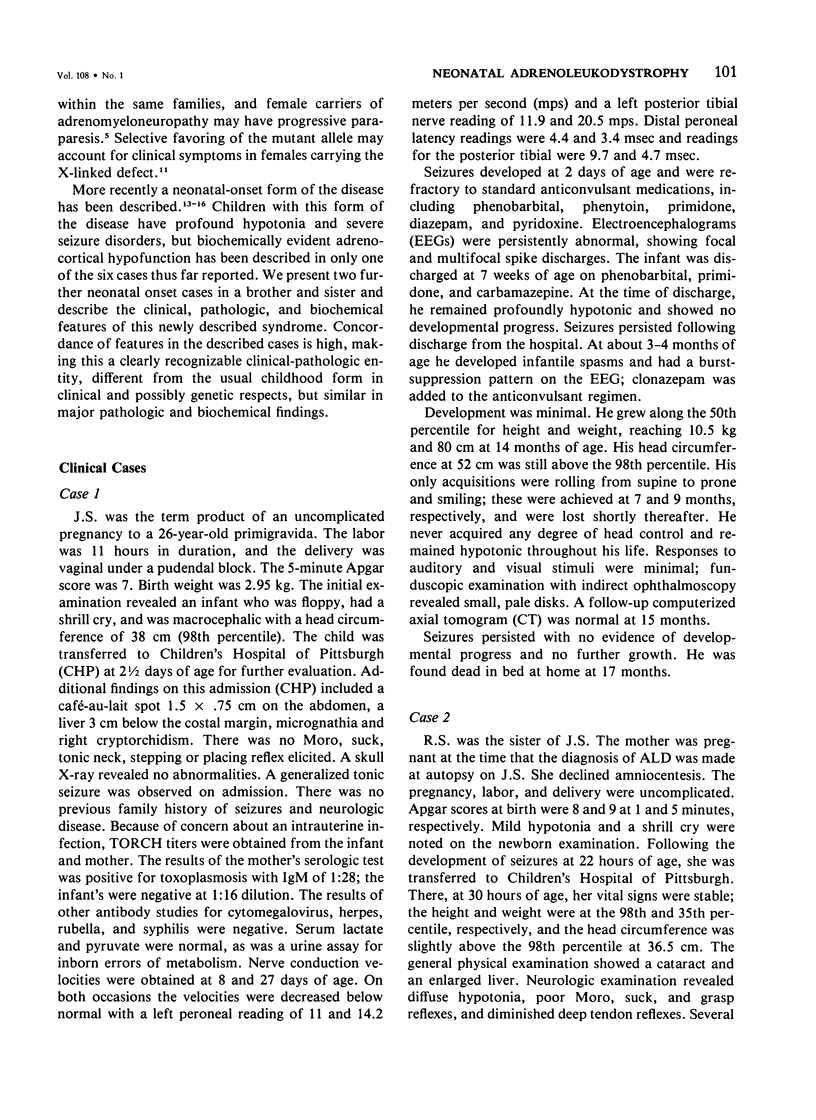
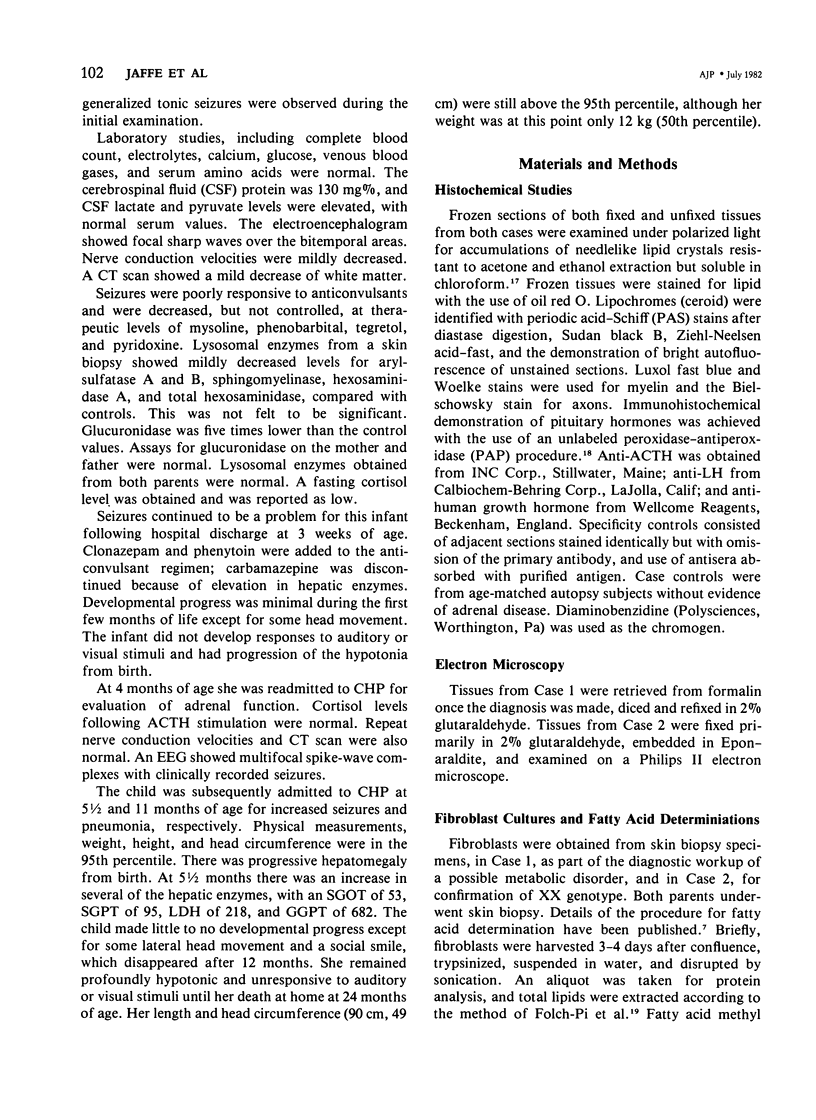
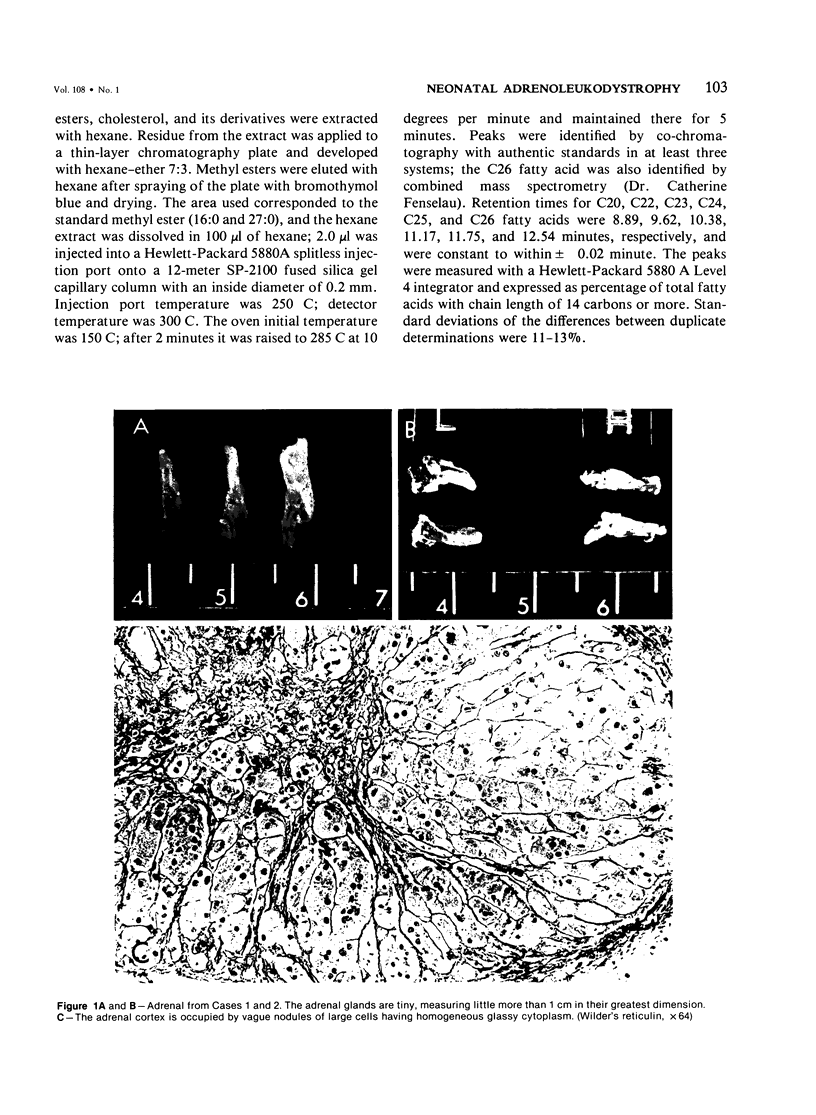
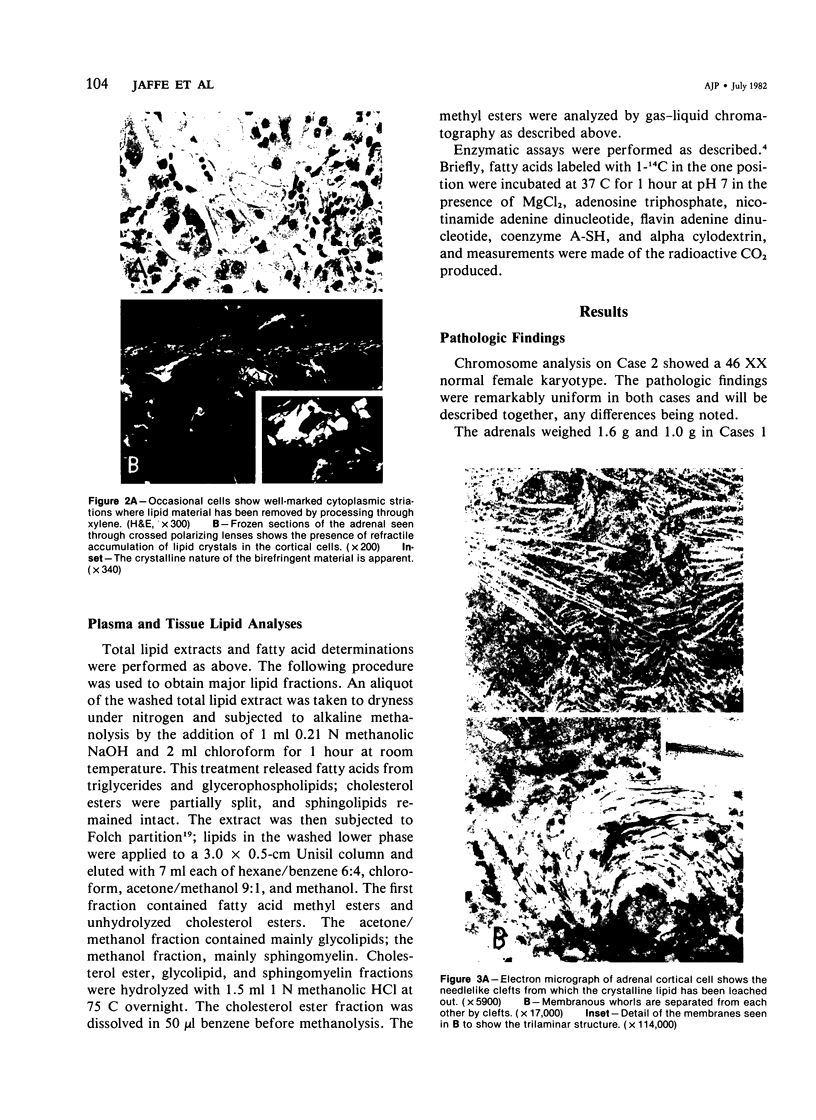
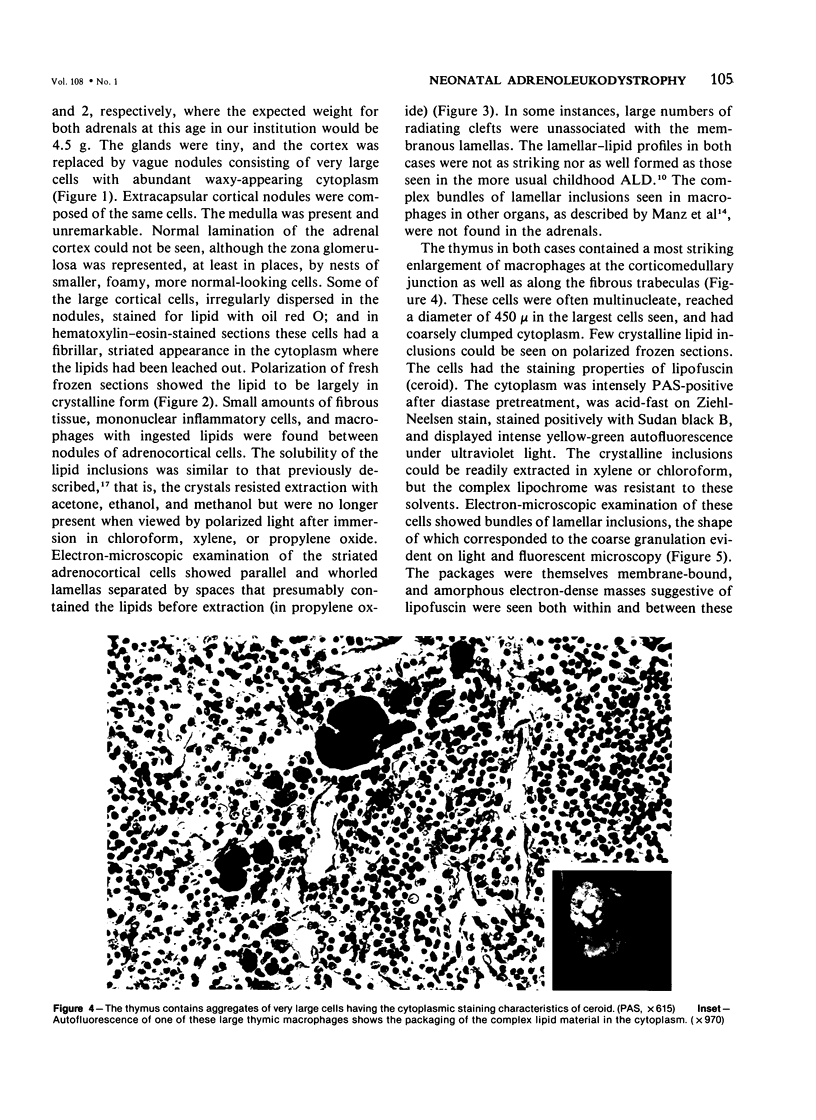
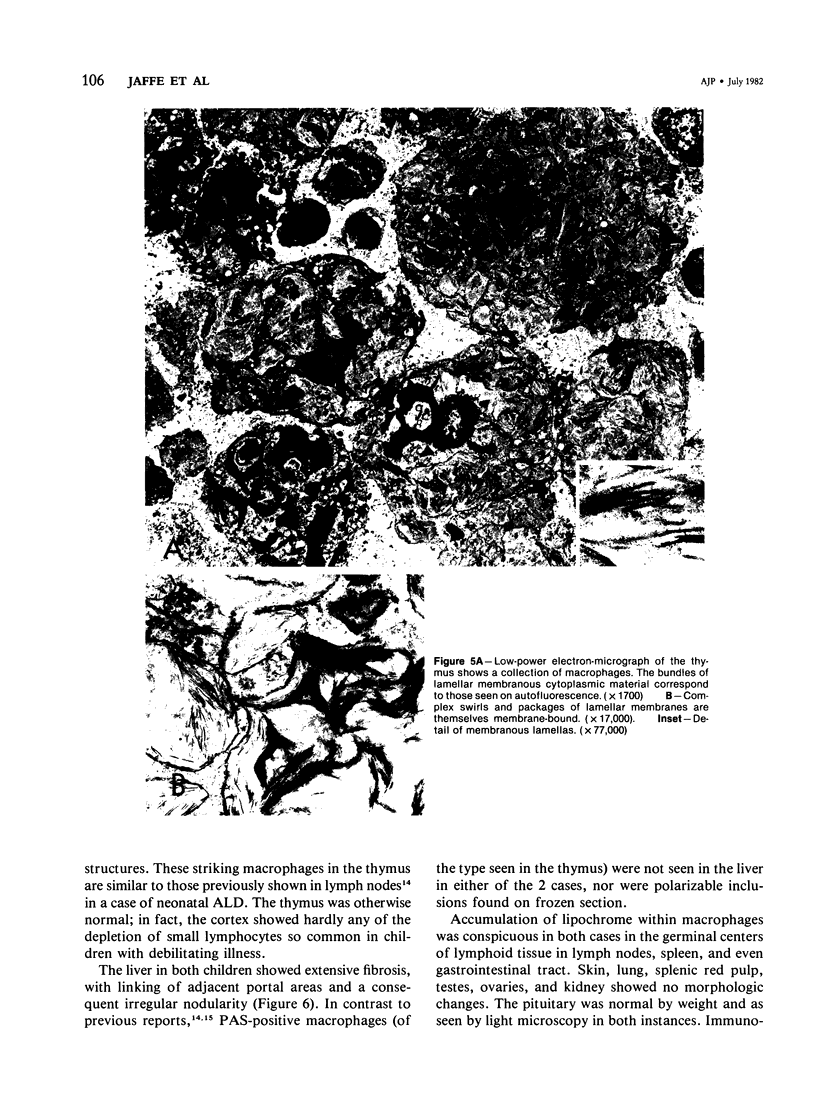
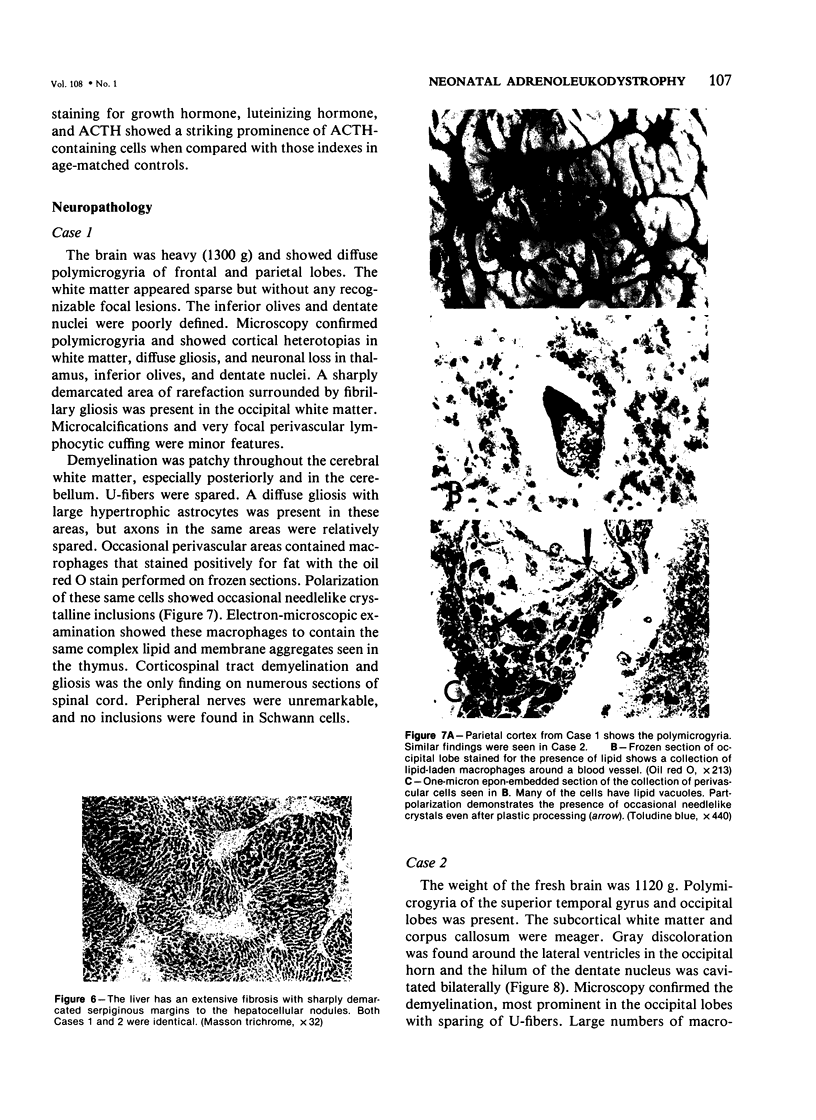
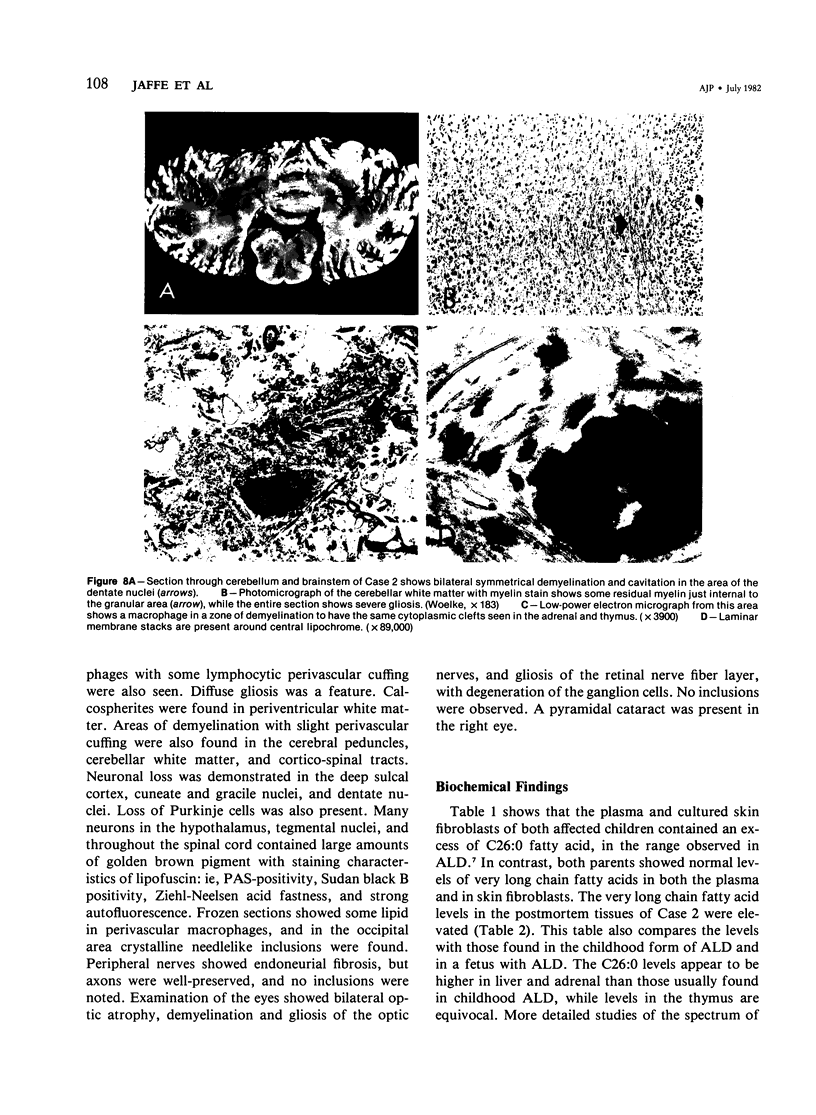
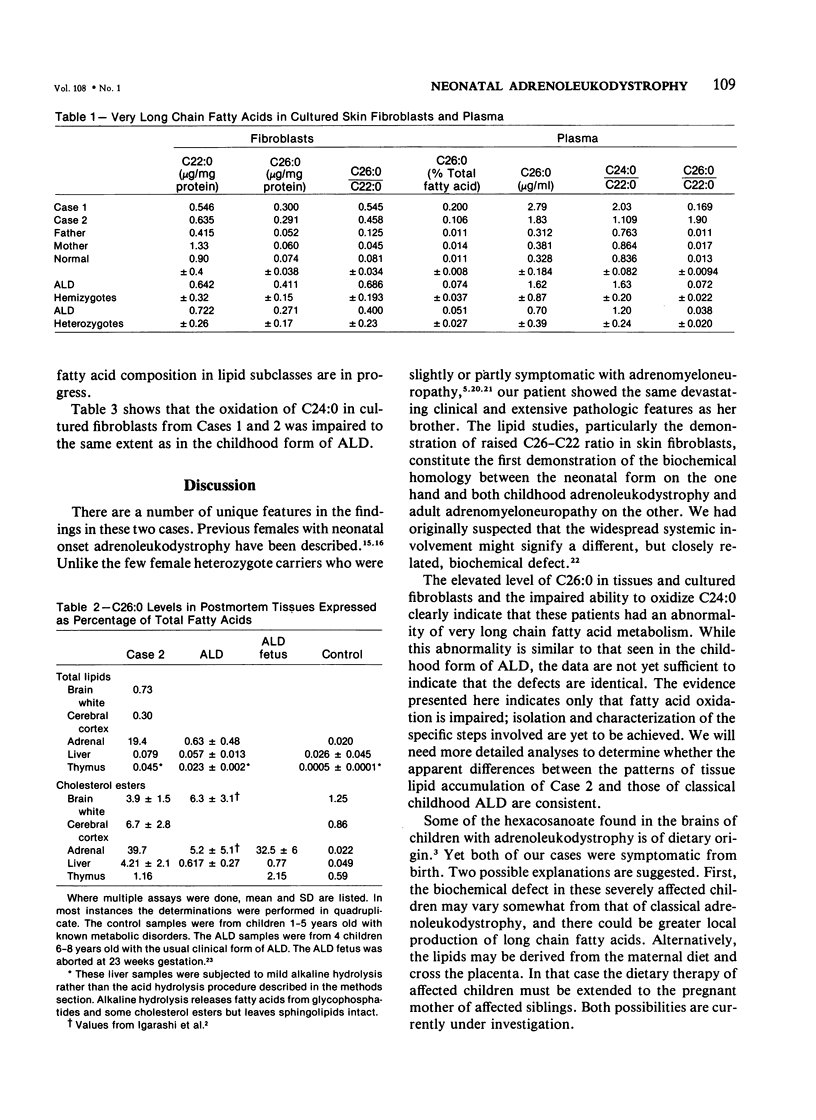
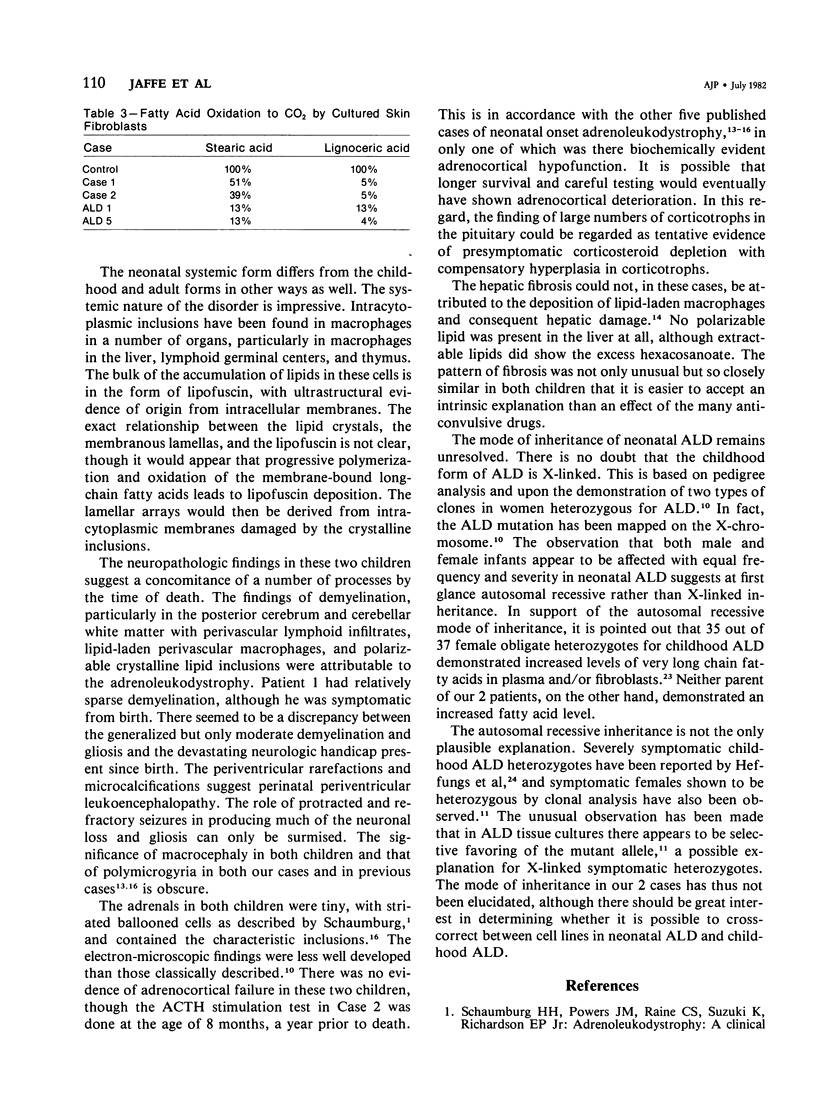
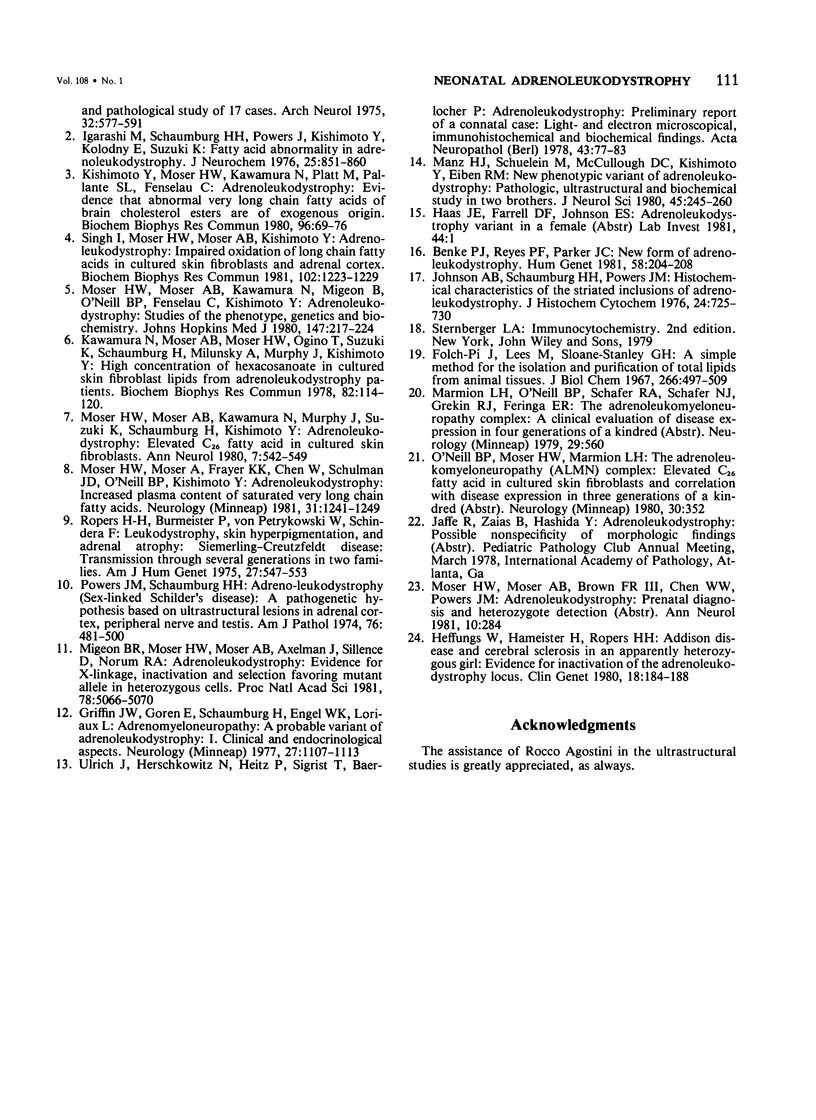
Images in this article
Selected References
These references are in PubMed. This may not be the complete list of references from this article.
- Benke P. J., Reyes P. F., Parker J. C., Jr New form of adrenoleukodystrophy. Hum Genet. 1981;58(2):204–208. doi: 10.1007/BF00278712. [DOI] [PubMed] [Google Scholar]
- Griffin J. W., Goren E., Schaumburg H., Engel W. K., Loriaux L. Adrenomyeloneuropathy: a probable variant of adrenoleukodystrophy. I. Clinical and endocrinologic aspects. Neurology. 1977 Dec;27(12):1107–1113. doi: 10.1212/wnl.27.12.1107. [DOI] [PubMed] [Google Scholar]
- Heffungs W., Hameister H., Ropers H. H. Addison disease and cerebral sclerosis in an apparently heterozygous girl: evidence for inactivation of the adrenoleukodystrophy locus. Clin Genet. 1980 Sep;18(3):184–188. doi: 10.1111/j.1399-0004.1980.tb00868.x. [DOI] [PubMed] [Google Scholar]
- Igarashi M., Schaumburg H. H., Powers J., Kishmoto Y., Kolodny E., Suzuki K. Fatty acid abnormality in adrenoleukodystrophy. J Neurochem. 1976 Apr;26(4):851–860. doi: 10.1111/j.1471-4159.1976.tb04462.x. [DOI] [PubMed] [Google Scholar]
- Johnson A. B., Schaumburg H. H., Powers J. M. Histochemical characteristics of the striated inclusions of adrenoleukodystrophy. J Histochem Cytochem. 1976 Jun;24(6):725–730. doi: 10.1177/24.6.59773. [DOI] [PubMed] [Google Scholar]
- Kawamura N., Moser A. B., Moser H. W., Ogino T., Suzuki K., Schaumburg H., Milunsky A., Murphy J., Kishimoto Y. High concentration of hexacosanoate in cultured skin fibroblast lipids from adrenoleukodystrophy patients. Biochem Biophys Res Commun. 1978 May 15;82(1):114–120. doi: 10.1016/0006-291x(78)90584-3. [DOI] [PubMed] [Google Scholar]
- Kishimoto Y., Moser H. W., Kawamura N., Platt M., Pallante S. L., Fenselau C. Adrenoleukodystrophy: evidence that abnormal very long chain fatty acids of brain cholesterol esters are of exogenous origin. Biochem Biophys Res Commun. 1980 Sep 16;96(1):69–76. doi: 10.1016/0006-291x(80)91182-1. [DOI] [PubMed] [Google Scholar]
- Manz H. J., Schuelein M., McCullough D. C., Kishimoto Y., Eiben R. M. New phenotypic variant of adrenoleukodystrophy. Pathologic, ultrastructural, and biochemical study in two brothers. J Neurol Sci. 1980 Mar;45(2-3):245–260. doi: 10.1016/0022-510x(80)90169-0. [DOI] [PubMed] [Google Scholar]
- Migeon B. R., Moser H. W., Moser A. B., Axelman J., Sillence D., Norum R. A. Adrenoleukodystrophy: evidence for X linkage, inactivation, and selection favoring the mutant allele in heterozygous cells. Proc Natl Acad Sci U S A. 1981 Aug;78(8):5066–5070. doi: 10.1073/pnas.78.8.5066. [DOI] [PMC free article] [PubMed] [Google Scholar]
- Moser H. W., Moser A. B., Frayer K. K., Chen W., Schulman J. D., O'Neill B. P., Kishimoto Y. Adrenoleukodystrophy: increased plasma content of saturated very long chain fatty acids. Neurology. 1981 Oct;31(10):1241–1249. doi: 10.1212/wnl.31.10.1241. [DOI] [PubMed] [Google Scholar]
- Moser H. W., Moser A. B., Kawamura N., Migeon B., O'Neill B. P., Fenselau C., Kishimoto Y. Adrenoleukodystrophy: studies of the phenotype, genetics and biochemistry. Johns Hopkins Med J. 1980 Dec;147(6):217–224. [PubMed] [Google Scholar]
- Moser H. W., Moser A. B., Kawamura N., Murphy J., Suzuki K., Schaumburg H., Kishimoto Y. Adrenoleukodystrophy: elevated C26 fatty acid in cultured skin fibroblasts. Ann Neurol. 1980 Jun;7(6):542–549. doi: 10.1002/ana.410070607. [DOI] [PubMed] [Google Scholar]
- Powers J. M., Schaumburg H. H. Adreno-leukodystrophy (sex-linked Schilder's disease). A pathogenetic hypothesis based on ultrastructural lesions in adrenal cortex, peripheral nerve and testis. Am J Pathol. 1974 Sep;76(3):481–491. [PMC free article] [PubMed] [Google Scholar]
- Ropers H. H., Burmeister P., Petrykowski W. v., Schindera F. Leukodystrophy, skin hyperpigmentation, and adrenal atrophy: Siemerling-Creutzfeldt disease. Transmission through several generations in two families. Am J Hum Genet. 1975 Jul;27(4):547–553. [PMC free article] [PubMed] [Google Scholar]
- Schaumburg H. H., Powers J. M., Raine C. S., Suzuki K., Richardson E. P., Jr Adrenoleukodystrophy. A clinical and pathological study of 17 cases. Arch Neurol. 1975 Sep;32(9):577–591. doi: 10.1001/archneur.1975.00490510033001. [DOI] [PubMed] [Google Scholar]
- Scientific Program of the American Academy of Neurology Thirty-second Annual Meeting, May 1-3, 1980, Hyatt Regency, New Orleans, Louisiana. Neurology. 1980 Apr;30(4):352–452. doi: 10.1212/wnl.30.4.352. [DOI] [PubMed] [Google Scholar]
- Singh I., Moser H. W., Moser A. B., Kishimoto Y. Adrenoleukodystrophy: impaired oxidation of long chain fatty acids in cultured skin fibroblasts an adrenal cortex. Biochem Biophys Res Commun. 1981 Oct 30;102(4):1223–1229. doi: 10.1016/s0006-291x(81)80142-8. [DOI] [PubMed] [Google Scholar]
- Ulrich J., Herschkowitz N., Heitz P., Sigrist T., Baerlocher P. Adrenoleukodystrophy. Preliminary report of a connatal case. Light- and electron microscopical, immunohistochemical and biochemical findings. Acta Neuropathol. 1978 Aug 7;43(1-2):77–83. doi: 10.1007/BF00685001. [DOI] [PubMed] [Google Scholar]



